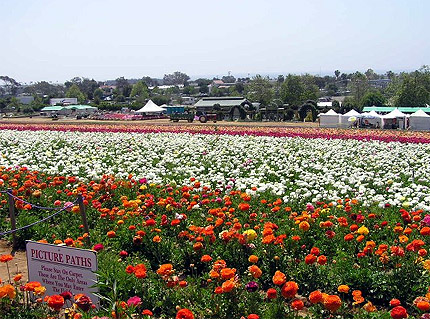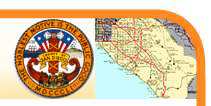|
THE
HISTORY

The Flower Fields of Carlsbad,
California
photo courtesy of The
Flower Fields
Although
it's name comes from a 19th century spa in Europe,
the city of Carlsbad's history includes many cultures.
The Luiseno Indians lived on the shores of Carlsbad's
coastal lagoon before the arrival of Don Gaspar
de Portola and Fr. Juan Crespi in 1769. Blazing
the trail now known as El Camino Real, they named
the lagoon for posterity - Agua Hedionda, which
means 'Stinking Water'.
More
soldiers and priests were soon to follow as they
were setting up pueblos and missions to ensure
Spain's hold on this remote territory. Mission
San Luis Rey was founded ten miles north of Agua
Hedionda lagoon in 1798.
In
1833, after Mexico won its independence from Spain,
the mission holdings were secularized. They were
now available by grants from the Mexican government.
Although the land grants were to be distributed
to everyone, it was the influential Californios
who ended up with most of them. Later this land
ended up with Irish born, Robert Kelly, who, in
turn, left the land to family members.
It
was after World War II, that this area enjoyed
a population increase due to it's proximity to
Pendleton Marine base and its return of veterans
to the area.
Since
it's incorporation in 1952, the City of Carlsbad's
population has increased almost 700 percent. The
area of the city has expanded to three times its
original size
.
Historical
Sites:
Leo
Carrillo Ranch - 4758 Palomar Airport
Road, Carlsbad
Also known as Rancho de Los Kiotes, Between
1937 and 1940, these adobe and wood buildings
were built by actor Leo Carrillo as a retreat,
working ranch, and tribute to old California culture
and architecture. The Leo Carrillo Ranch, with
its Flying 'LC' brand, originally covered 2,538
acres and was frequented by Carrillo and his friends
until 1960. Leo Carrillo was a strong, positive,
and well-loved role model who sought to celebrate
California's early Spanish heritage, through a
life of good deeds and charitable causes.
(760)
476-1042
|



![]()

